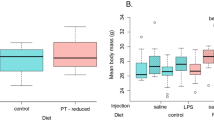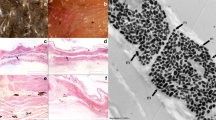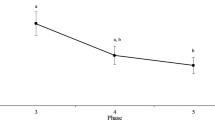A genetic factor that encourages this form of farmyard bullying has been identified.
Abstract
Feather-pecking in domestic birds is associated with cannibalism and severe welfare problems1. It is a dramatic example of a spiteful behaviour in which the victim's fitness is reduced for no immediate direct benefit to the perpetrator2 and its evolution is unexplained. Here we show that the plumage pigmentation of a chicken may predispose it to become a victim: birds suffer more drastic feather-pecking when the colour of their plumage is due to the expression of a wild recessive allele at PMEL17, a gene that controls plumage melanization3, and when these birds are relatively common in a flock. These findings, obtained using an intercross between a domestic fowl and its wild ancestor, have implications for the welfare of domestic species and offer insight into the genetic changes associated with the evolution of feather-pecking during the early stages of domestication.
This is a preview of subscription content, access via your institution
Access options
Subscribe to this journal
Receive 51 print issues and online access
$199.00 per year
only $3.90 per issue
Buy this article
- Purchase on Springer Link
- Instant access to full article PDF
Prices may be subject to local taxes which are calculated during checkout

Similar content being viewed by others
References
Blokhuis, H. J. & Wiepkema, P. R. Vet. Quart. 20, 6–9 (1998).
Johnstone, R. A. & Bshary, R. Proc. R. Soc. Lond. B 271, 1917–1922 (2004).
Kerje, S. et al. Genetics (in the press).
Smyth, J. R. in Poultry Breeding and Genetics (ed. Crawford, R. D.) 109–167 (Elsevier Science, New York, 1996).
McAdie, T. M. & Keeling, L. J. Appl. Anim. Behav. Sci. 75, 147–159 (2002).
Savory, C. J. & Mann, J. S. Brit. Poult. Sci. 40, 565–572 (1999).
Jensen, P. et al. ISAE 2003 Meeting, June 24–28, 68 (2003).
Kjaer, J. B. & Sørensen, P. Brit. Poult. Sci. 38, 333–341 (1997).
Buithenhuis, A. J. et al. Poult. Sci. 82, 1661–1667 (2003).
Buithenhuis, A. J. et al. Poult. Sci. 82, 1215–1222 (2003).
Author information
Authors and Affiliations
Corresponding author
Ethics declarations
Competing interests
The authors declare no competing financial interests.
Supplementary information
Rights and permissions
About this article
Cite this article
Keeling, L., Andersson, L., Schütz, K. et al. Feather-pecking and victim pigmentation. Nature 431, 645–646 (2004). https://doi.org/10.1038/431645a
Published:
Issue Date:
DOI: https://doi.org/10.1038/431645a
This article is cited by
-
Phenotype alteration causes long-term changes to the social strategies of victimised birds
Scientific Reports (2023)
-
Breeding history and candidate genes responsible for black skin of Xichuan black-bone chicken
BMC Genomics (2020)
-
Effects of commercial hatchery processing on short- and long-term stress responses in laying hens
Scientific Reports (2019)
-
Feralisation targets different genomic loci to domestication in the chicken
Nature Communications (2016)
-
Genetic parameters and signatures of selection in two divergent laying hen lines selected for feather pecking behaviour
Genetics Selection Evolution (2015)
Comments
By submitting a comment you agree to abide by our Terms and Community Guidelines. If you find something abusive or that does not comply with our terms or guidelines please flag it as inappropriate.



